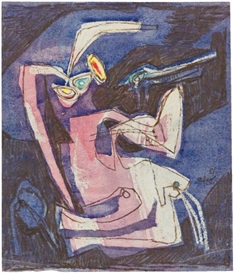In the Video "More Human Than Human", we learn the reasoning behind why humans are so obsessed with the human body in art. Also, we learned why we are so in awe when we see the human body in distortion. One theory explained by the video was how societies view structure. For example, the Egyptians run in an organized and strict society. If you look at all the Egyptians' drawings of the human body, they are all almost identical in form. This is because each form of the human body fits a distinct grid patter that align perfectly. Also, the images are distorted because they emphasize the important parts of the human body in the most important angles. Here is an example of the grip system they use to draw out the human form:

Another idea they came up with is how many humans exaggerate the most important parts of the human body they think are the most important or the most significant to that person. For instance, if there is a sculpture or drawing of a person, and the head is ten times bigger than the rest of the body, this might be a representation of how the artist felt the brain was the most important part of the body. This video gave depth to the textbook about the workings of the minds of humans when creating these images of the human body.
I chose the video "The Measure of All Things: Greek Art and the Human Figure" because Greek art, science, and philosophy has always intrigued me. Their logical way of thinking is simple and pure. In this video, they are explaining how Ancient Greeks were trying to deviate from the Egyptians two dimensional human view and started moving towards art that is three dimensional, and more human like. They incorporate all human features and emotions into the sculptor to make them look almost life-like. Both these videos were truly helpful in understanding why so many artists have adopted the idea to create the human body through art in their own distinct ways.





